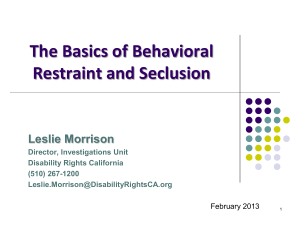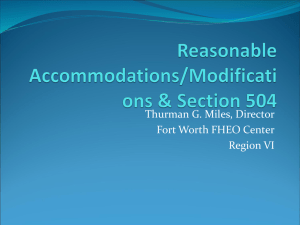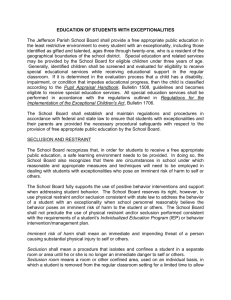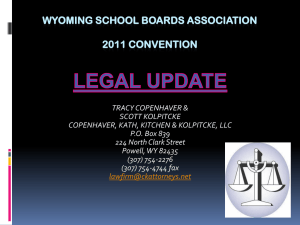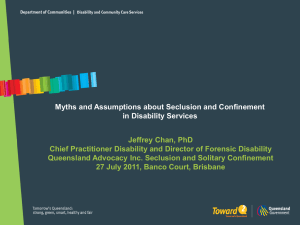PM Attachment 7.3.1, Seclusion & Restraint Monitoring Requirements
advertisement
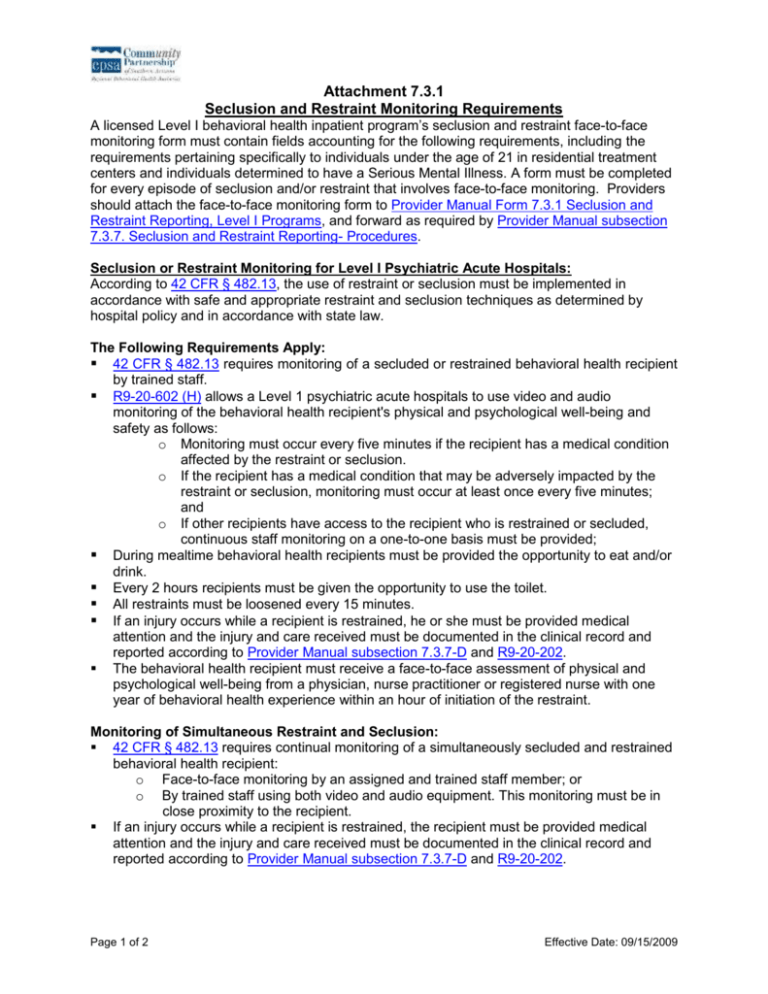
Attachment 7.3.1 Seclusion and Restraint Monitoring Requirements A licensed Level I behavioral health inpatient program’s seclusion and restraint face-to-face monitoring form must contain fields accounting for the following requirements, including the requirements pertaining specifically to individuals under the age of 21 in residential treatment centers and individuals determined to have a Serious Mental Illness. A form must be completed for every episode of seclusion and/or restraint that involves face-to-face monitoring. Providers should attach the face-to-face monitoring form to Provider Manual Form 7.3.1 Seclusion and Restraint Reporting, Level I Programs, and forward as required by Provider Manual subsection 7.3.7. Seclusion and Restraint Reporting- Procedures. Seclusion or Restraint Monitoring for Level I Psychiatric Acute Hospitals: According to 42 CFR § 482.13, the use of restraint or seclusion must be implemented in accordance with safe and appropriate restraint and seclusion techniques as determined by hospital policy and in accordance with state law. The Following Requirements Apply: 42 CFR § 482.13 requires monitoring of a secluded or restrained behavioral health recipient by trained staff. R9-20-602 (H) allows a Level 1 psychiatric acute hospitals to use video and audio monitoring of the behavioral health recipient's physical and psychological well-being and safety as follows: o Monitoring must occur every five minutes if the recipient has a medical condition affected by the restraint or seclusion. o If the recipient has a medical condition that may be adversely impacted by the restraint or seclusion, monitoring must occur at least once every five minutes; and o If other recipients have access to the recipient who is restrained or secluded, continuous staff monitoring on a one-to-one basis must be provided; During mealtime behavioral health recipients must be provided the opportunity to eat and/or drink. Every 2 hours recipients must be given the opportunity to use the toilet. All restraints must be loosened every 15 minutes. If an injury occurs while a recipient is restrained, he or she must be provided medical attention and the injury and care received must be documented in the clinical record and reported according to Provider Manual subsection 7.3.7-D and R9-20-202. The behavioral health recipient must receive a face-to-face assessment of physical and psychological well-being from a physician, nurse practitioner or registered nurse with one year of behavioral health experience within an hour of initiation of the restraint. Monitoring of Simultaneous Restraint and Seclusion: 42 CFR § 482.13 requires continual monitoring of a simultaneously secluded and restrained behavioral health recipient: o Face-to-face monitoring by an assigned and trained staff member; or o By trained staff using both video and audio equipment. This monitoring must be in close proximity to the recipient. If an injury occurs while a recipient is restrained, the recipient must be provided medical attention and the injury and care received must be documented in the clinical record and reported according to Provider Manual subsection 7.3.7-D and R9-20-202. Page 1 of 2 Effective Date: 09/15/2009 Attachment 7.3.1 Seclusion and Restraint Monitoring Requirements The recipient must receive a face-to-face assessment of physical and psychological wellbeing from a physician, nurse practitioner or registered nurse with one year of behavioral health experience within an hour of initiation of the restraint. Additional Requirements for Clients Determined to have a SMI R9-21-204(P) requires face-to-face monitoring at a minimum every 15 minutes to ensure the behavioral health recipient’s comfort and safety and determine the need for food, fluid, bathing, and access to the toilet. R9-21-204(P) requires that a registered nurse must personally examine the recipient every hour to assess his/her mental and physical condition and ensure the continued well-being. For a recipient who is restrained, R9-21-204(P) requires that there be a determination of whether continuous monitoring by one-to-one staff is needed, and when continuous monitoring is determined to be needed, that it is made available. Seclusion or Restraint Monitoring for Residents under the Age of 21 in Sub-Acute Agencies or Residential Treatment Centers The Following Requirements Apply: R9-20-602 requires face-to-face monitoring of a secluded or restrained behavioral health recipient, a minimum of every 15 minutes. o Monitoring must occur every five minutes if the recipient has a medical condition affected by the restraint or seclusion. During mealtime the recipient must be provided the opportunity to eat and/or drink. Every 2 hours the recipient must be given the opportunity to use the toilet. All restraints must be loosened every 15 minutes. If an injury occurs while the recipient is secluded or restrained, he or she must be provided medical attention and the injury and care received must be documented in the clinical record and reported according to Provider Manual subsection 7.3.7-D and R9-20-202. The recipient must receive a face-to-face assessment of physical and psychological wellbeing within an hour of initiation of seclusion or restraint, performed by a registered nurse with minimum of one year of behavioral health experience, nurse practitioner or physician. Additional Requirements for Individuals Under Age 21 in Residential Treatment Centers 42 CFR § 483.362 prohibits the monitoring with video and/or audio equipment when restraining individuals under the age of 21 residing in residential treatment centers. 42 CFR §§ 483.362-.364 prohibits the monitoring with video and/or audio equipment when secluding individuals under the age of 21 residing in residential treatment centers. Staff must be physically present in or immediately outside the seclusion room. 42 CFR § 483.356 prohibits the simultaneous use of restraint and seclusion with individuals under age 21 residing in residential treatment centers. Page 2 of 2 Effective Date: 09/15/2009



